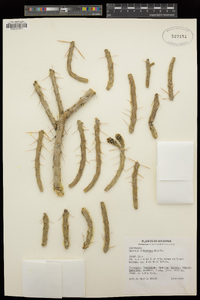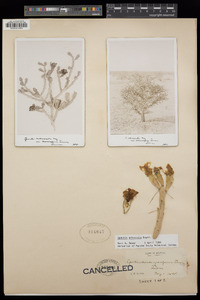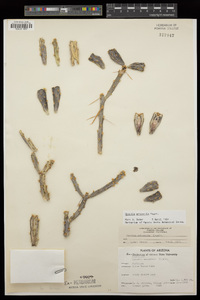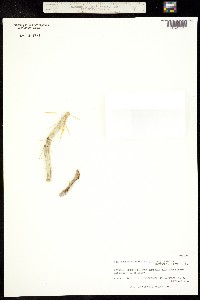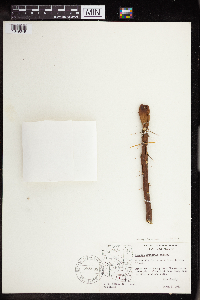Cylindropuntia arbuscula
|
|
|
|
Family: Cactaceae
Arizona Pencil Cholla, more...pencil cholla (es: siviri, clavellina)
[Cylindropuntia vivipara, moreOpuntia arbuscula Engelm.] |
Trees or shrubs, densely branched, 0.5-3 m. Stem segments green, sometimes purple tinged, 6-10.5 × 0.5-1.3 cm; tubercles narrowly elongate, appearing as wrinkles when dry, 1-2 cm; areoles circular, 2-3 mm in diam.; wool tan to brown, aging gray to black. Spines 0-2(-3) per areole, sparsely distributed along stem, usually deflexed, pale yellow or red-brown aging black, stout, the longest 0.8-3.5(-5) cm; sheaths loose fitting, yellowish brown. Glochids in adaxial tuft and marginal, encircling areole, pale yellow. Flowers: inner tepals green- or orange-bronze, spatulate, 17-20 mm, apiculate; filaments dark green-bronze; anthers yellow; style whitish basally to light orange apically; stigma lobes very pale green. Fruits green, becoming yellowish apically, sometimes tinged red to purplish at areoles, commonly sterile, then narrow, tuberculate, to 2.5 cm, fertile ones stipitate, obconic, 20-50 × 15-35 mm, fleshy, becoming smooth, spineless; umbilicus 3-4 mm deep; areoles 15-17(-34). Seeds pale yellow, angularly circular to oblong, thick, 3-5 mm diam., lumpy; girdle smooth, broad, not protruding. 2n = 66. Flowering spring (Apr-Jun). Sonoran Desert flats, bajadas, desert scrub; 300-1000 m; Ariz.; Mexico (Sonora). Cylindropuntia arbuscula forms hybrids with C. leptocaulis in south-central Arizona; those hybrids have narrow, obscurely tuberculate stems and reddish fruits nearly the size of those of C. arbuscula and chromosome number of 2n = 55. Hybrids between C. arbuscula and C. spinosior [= C . ×neoarbuscula (Griffiths) F. M. Knuth] have large green fruits, which often split open, and on stem segments distal areoles that usually bear three or four spines to 2.5 cm. Hybrids between C. arbuscula and C. versicolor [= C . ×vivipara (Rose) F. M. Knuth] have large green fruits, which often split open, and distal stem segment areoles that bear one or two spines to 1.5 cm.
Plant: Tree or shrub, much branched, 0.5-3 m tall; STEM segments green, sometimes purple-tinged, 6-10.5 cm long, 0.5-1.3 cm in diam.; tubercles obscure, narrowly elongate appearing as wrinkles when dry, 1-2 cm long. AREOLES tan- to brown-felty, aging gray to black, circular, 2-3 mm in diam Leaves: SPINES 0-2(-3), sparsely distributed along stem, pale yellow to red-brown aging black, stout, usually deflexed, the longest 0.8-3.5(-5) cm long; sheaths loose-fitting, yellowish brown. GLOCHIDS pale yellow, in an apical tuft with a few marginal ones, encircling areole Flowers: inner tepals dark bronze to orange bronze, spatulate, apiculate, 1.7-2 cm long; filaments dark green-bronze, the anthers yellow; style whitish basally to light orange apically; stigmas very pale green Fruit: green becoming yellowish apically, sometimes purplish at areoles, obconic-stipitate, commonly sterile, narrow and tuberculate to 2.5 cm long, the fertile ones obconic-stipitate, becoming smooth, spineless, fleshy, 2.5-5 cm long, 1.5-3.5 cm in diam., the umbilicus 3-4 mm deep; areoles 15-17(-34). SEEDS 3-5 mm in diam., pale yellow, angularly circular to oblong, thick, lumpy, the girdle smooth, not protruding Misc: Desert flats and bajadas, desertscrub; 350-1000 m (1000-3300 ft); Apr-Jun REFERENCES: Pinkava, Donald J. 1999. Cactaceae. Ariz. - Nev. Acad. Sci. 32(1). Felger 2000, Kearney and Peebles 1969, Pinkava 1999 Common Name: Arizona pencil cholla Duration: Perennial Protected Status: Salvage restriced status in Arizona. General: Shrubby chollas that are 1-2.5 m, as wide or wider than tall, intricately branched with a dense crown, the trunk short, often well developed, up to 15 cm to the lowest branch, can reach 16 cm in diameter. The bark smooth and dark bronze on older branches and young trunks, becoming dark gray, scaly, and flaking with age, usually much branched above, the joints 3.5-15 cm long, 7-12 mm wide, green to yellow-green all year, becoming shorter upwards. Spines: Spines 0-5 and sparsely distributed along stem, pale yellow at apex to red-brown at base, aging black, stout and usually deflexed, the longest 1-5 cm long; sheaths loose-fitting, yellowish brown. The glochids are pale yellow and encircle the areole in an apical tuft with only a few marginal ones. Flowers: The inner tepals are dark bronze to orange bronze to a greenish yellow or yellow brown, spatulate, apiculate, 1.5-2 cm long, with dark green-bronze filaments and yellow anthers with a style that is whitish basally to light orange apically with very pale green stigmas. Fruits: Green even when ripe, becoming yellowish apically, sometimes purplish at areoles, commonly sterile, narrow and tuberculate to 2.5 cm long, the fertile ones obconic-stipitate, becoming smooth and spineless, fleshy, 2.5-5 cm long, 1.5-3.5 cm in diameter, wi Ecology: Found in sandy-silty or granitic soils, bajadas, desertscrub, small washes, shallow drainages and in Larrea flats from 1,000-3,500 ft (305-1067 m), flowers April-June. Notes: During years of drought flower buds often dry without opening. Ethnobotany: Fruits boiled with saltbush and used for food, calyxes pit roasted with inkweed and dried for future use or eaten fresh, flowers pit roasted and eaten, the young joints boiled and eaten as a vegetable in times of want by the Papago. Etymology: Cylindropuntia is from Greek kylindros or a cylinder, plus the genus Opuntia, while arbuscula means resembling a small tree. Synonyms: Opuntia arbuscula Editor: LCrumbacher, 2010 |
|
|
|






























